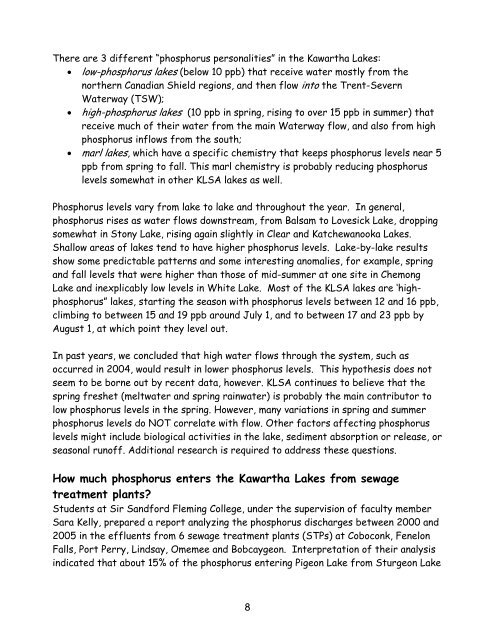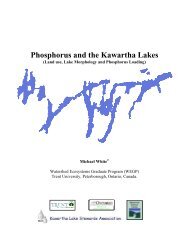Lake Water Quality 2006 Report - Lakefield Herald
Lake Water Quality 2006 Report - Lakefield Herald
Lake Water Quality 2006 Report - Lakefield Herald
You also want an ePaper? Increase the reach of your titles
YUMPU automatically turns print PDFs into web optimized ePapers that Google loves.
There are 3 different “phosphorus personalities” in the Kawartha <strong>Lake</strong>s:• low-phosphorus lakes (below 10 ppb) that receive water mostly from thenorthern Canadian Shield regions, and then flow into the Trent-Severn<strong>Water</strong>way (TSW);• high-phosphorus lakes (10 ppb in spring, rising to over 15 ppb in summer) thatreceive much of their water from the main <strong>Water</strong>way flow, and also from highphosphorus inflows from the south;• marl lakes, which have a specific chemistry that keeps phosphorus levels near 5ppb from spring to fall. This marl chemistry is probably reducing phosphoruslevels somewhat in other KLSA lakes as well.Phosphorus levels vary from lake to lake and throughout the year. In general,phosphorus rises as water flows downstream, from Balsam to Lovesick <strong>Lake</strong>, droppingsomewhat in Stony <strong>Lake</strong>, rising again slightly in Clear and Katchewanooka <strong>Lake</strong>s.Shallow areas of lakes tend to have higher phosphorus levels. <strong>Lake</strong>-by-lake resultsshow some predictable patterns and some interesting anomalies, for example, springand fall levels that were higher than those of mid-summer at one site in Chemong<strong>Lake</strong> and inexplicably low levels in White <strong>Lake</strong>. Most of the KLSA lakes are ‘highphosphorus”lakes, starting the season with phosphorus levels between 12 and 16 ppb,climbing to between 15 and 19 ppb around July 1, and to between 17 and 23 ppb byAugust 1, at which point they level out.In past years, we concluded that high water flows through the system, such asoccurred in 2004, would result in lower phosphorus levels. This hypothesis does notseem to be borne out by recent data, however. KLSA continues to believe that thespring freshet (meltwater and spring rainwater) is probably the main contributor tolow phosphorus levels in the spring. However, many variations in spring and summerphosphorus levels do NOT correlate with flow. Other factors affecting phosphoruslevels might include biological activities in the lake, sediment absorption or release, orseasonal runoff. Additional research is required to address these questions.How much phosphorus enters the Kawartha <strong>Lake</strong>s from sewagetreatment plants?Students at Sir Sandford Fleming College, under the supervision of faculty memberSara Kelly, prepared a report analyzing the phosphorus discharges between 2000 and2005 in the effluents from 6 sewage treatment plants (STPs) at Coboconk, FenelonFalls, Port Perry, Lindsay, Omemee and Bobcaygeon. Interpretation of their analysisindicated that about 15% of the phosphorus entering Pigeon <strong>Lake</strong> from Sturgeon <strong>Lake</strong>8





